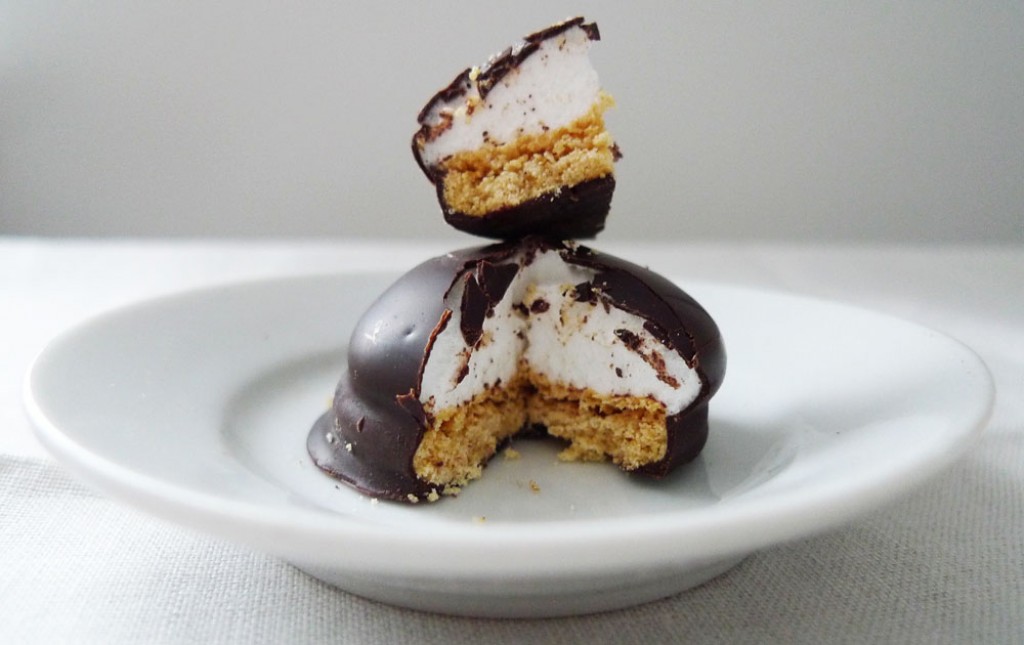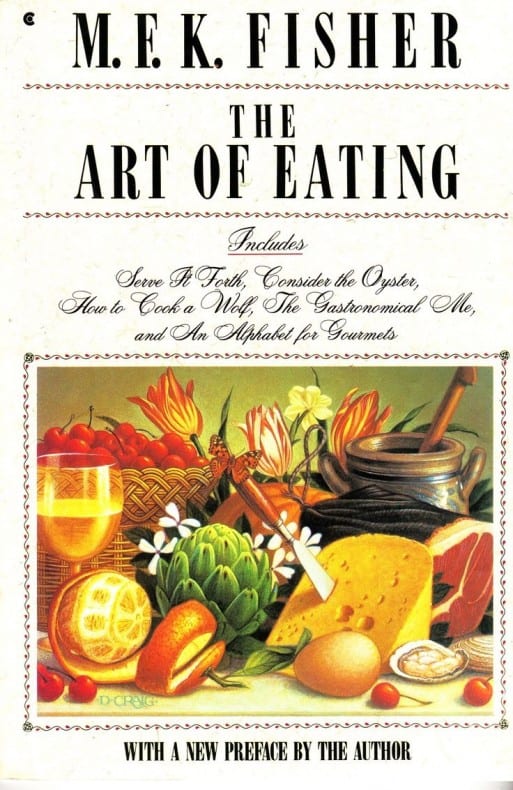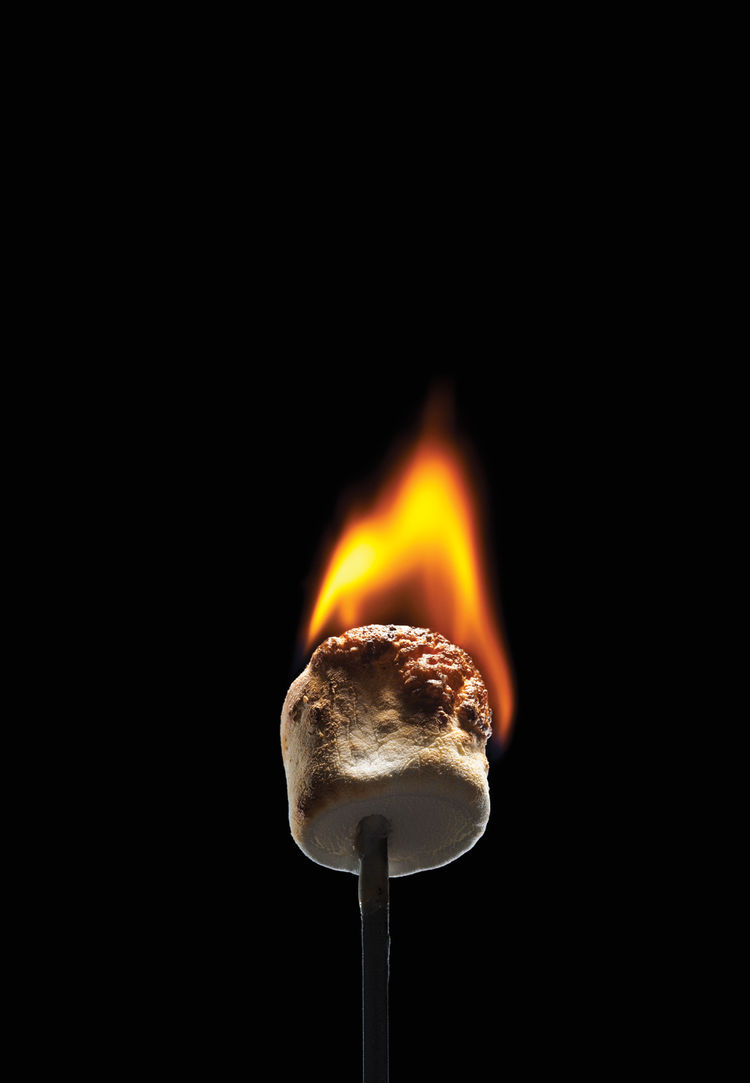Recently, Refinary 29 polled their staff about food behavior they indulged in ONLY alone and in private: a healing, off-the-grid oasis in the always-on, politically correct, anxiety-making world. They included eating an entire box of instant Mac-and-Cheese out of the pot while watching episodes of Downton Abbey or The Office; Ample Hills Creamery Salted Crack Caramel ice cream sandwiched between two Stroopwafel cookies, consumed standing over the sink; straight out-of-the-jar spoonfuls of peanut butter studded with dark chocolate chips; leftover steak eaten with the hands “like a cavewoman“.

Everyone I know, including some stellar chefs, all have their moments of retreat into dark hungers and unique combos of flavors. The practice is deeply personal and satisfying, but now new. M.F.K. Fisher wrote about the odd combinations people ate when they were alone her book Serve It Forth in 1937 (see the excerpt, below). She called them “secret eatings“. She was fond of peeled tangerine sections that she’d left drying on the radiator all day, until the outside had formed a thin, crackly shell and the perfume had deepened. “My pleasure in them is subtle and voluptuous and quite inexplicable.”

I’ve written about a few creations from my late-night, sweet-tooth-fueled foraging: a seven-layer “cake” of amaretti cookies (Pepperidge Farm butter cookies or chocolate wafers would do) and creme fraiche…peanut butter and dulce de leche caramel (which were side-by-side in the fridge) mixed together and eaten with a spoon…peanut butter sandwiched between chunks of chocolate to make a down-and-dirty peanut butter cup…
Here are several longtime favorite “secret suppers and private snacks” from my files. (It leaves out grilled bread drizzled with good olive oil and sprinkled with sugar.)

PanFried Mac-and-Cheese
Pan-frying slices of a cold, leftover mac-and-cheese — whether homemade or a hunk of store-bought— renders the outside crisp and chewy, the interior molten. The elegance of presentation will depend on the thickness and neatness of your mac-and-cheese; slices work well, but just making patties is fine.
Slice chilled leftover macaroni and cheese into slices roughly 1/3-to 1/2-inch thick OR form it into 1/2-inch thick patties. Sprinkle all-purpose flour, Wondra, rice flour or grated Parmigiano in a pie plate and dredge the slices to coat each side. Heat some extra virgin olive oil or butter in a cast-iron or nonstick skillet until hot but not smoking. Carefully lift the slices out of the flour, knock off the excess flour and transfer them in one layer to the pan. Fry about 3 minutes on each side until golden and crisp. Eat at once.

Toasted Marshmallows, Cheese or Chocolate
One evening when I was desperate for a sweet, I stuck a bamboo skewer into a fat white marshmallow and held it over a gas flame. I adjusted its height over the flame as necessary to “brulee” the marshmallow evenly to make a little puffy, molten vanilla meringue in a chewy shell of caramel, burnt to my preference, from golden to black. Every few minutes, I’d pull the caramelized outer layer off with my fingers and gingerly pop it in my mouth; then I’d return the molten core to the flame to toast it some more. The effect is delightful and curious: in the privacy of your home you can have the pleasures of a childhood campfire, and its memories. There’s simply NO reason to reserve toasting marshmallows ONLY for an outdoors campfire. Here are a few tips:
—If you only have an electric burner, hold the marshmallow about 1 inch above the coil (turned on high). In a pinch, use a candle.
—In the woods, you’d use a thin green sapling (stripped of leaves) to spear the marshmallows. Kitchen alternatives include a two-prong kitchen fork, a chopstick, or a bamboo or metal skewer.
—Any kind of marshmallow will do: from blatantly commercial Sta-Puff to the square hand-made ones sold in high-end markets.
—You can apply this method with a chunk of cheese or chocolate, eating the outer layers as they melt to the perfect degree (for you), until it is all gone.

Mallomars. Winter is Mallomar season and, as we learned from our friend Fern Berman, there are MANY ways to eat a Mallomar without doing a lick of preparation; each way has its own, very personal delight. You’ll find inspiration here. If they’re not in your local store, order them fresh from Amazon here. (They make a surprising and welcome holiday gift.)


Pasta Fries
Inspired by the crispy satisfaction of oven French fries but not wanting to cut potatoes, I tried using tube pasta to make something like the chewy noodles on the top of baked pasta casseroles like macaroni-and-cheese and my Big Macaroni casserole. A dusting of grated Parmigiano caramelizes on the pasta as it roasts insuring a crisp-chewy texture. Although you can use almost any pasta, French fry-shaped tube pastas, such as trenne, penne, ziti or strozzapretti, or long, twisted pastas are the most fun to eat.
In a large pot of salted, boiling water, cook 12 ounces tube pasta until al dente (tender but still slightly firm to the bite). Pour into a colander to drain several minutes. Meanwhile, in a small saucepan, melt 1 1/2 tablespoons butter over low heat. Add 1 peeled, roughly-crushed-but-intact garlic clove; swirl several times to infuse; turn off the heat. Grease a large, heavy baking sheet or two large ovenproof cast-iron or nonstick skillets with a little of the butter.
Pour the pasta onto the baking sheet. Pour the butter over and toss to coat completely; add salt and pepper to taste. Shake the pan to let the pasta spread out and settle. Sprinkle with 2/3 to 3/4 cup grated Parmigiano cheese.
Bake the pasta in a 475’ oven until the top is golden and crisp, 25 to 30 minutes. Serve at once.

Molten Mozzarella Grilled Cheese on a Blistered Corn Tortilla
I learned of the sublime affinity of mozzarella, black olive paste and corn bread from the great food writer John Thorne years ago. It led me to this devise a satisfying, ultra-quick open-faced version using corn tortillas. I blister them in a hot iron skillet, spread them with olive paste and mozzarella and cover until the cheese is molten. They are best eaten standing by the stove as they come out of the pan.
Sometimes I skip the olive paste and scatter chopped anchovies over the mozzarella….sometimes I make it with just mozzarella or whatever cheese I have on hand grated or thinly sliced.
Thinly slice or shred 3 to 4 ounces fresh mozzarella; if wet, blot dry gently with paper towels. Heat a small cast iron skillet until very hot; reduce heat to moderate and add a corn tortilla. Cook 1 minute and flip; cook 1 minute longer until the tortilla is lightly blistered and beginning to puff. Remove the tortilla from the pan. Working quickly, brush the top of the tortilla with a halved garlic clove. Spread 1 teaspoon black olive paste over the tortilla, leaving a 1/2-inch border uncovered. Then arrange about an ounce+ of mozzarella cheese over the top. Slide a metal spatula under the tortilla to transfer it back to the pan. Cover the pan and cook until the cheese is molten, 1 1/2 to 2 minutes. Remove the tortilla to a cutting board, cut into quarters and grind black pepper over the top. As soon as you’ve finished eating the first, throw another tortilla in the hot pan to start the whole process over again.

Excerpt from On Dining Alone By M.F.K. Fisher (collected in The Art of Eating:
I have known two people who understood…One was an old man….
I never knew who he was. Whenever we went to Victor Hugo’s he was there, at a quiet corner table. He was dressed carefully in rather old-fashioned dinner clothes, with his feet in tiny twinkling pumps, like a doll’s.
He ate little, and drank a half-bottle of wine with his meat. For dessert he went through a never-varying formula with the intensity and detachment of a high priest.
An avocado was brought to him, cradled in a napkin. He felt of it delicately, smelled it, usually nodded yes. It was cut in two with a silver knife. Then he himself detached the stone-skin from each half, placed one part of the fruit gently on a large plate before him, and sent the other back to the kitchen.
Powdered sugar was brought, and the old man pressed it into the hollow of the fruit. He spent some time over this, making it firm and even.
Next the sommelier appeared with a [bear]-shaped bottle of clear Russian kümmel. He poured a generous liqueur glass of it, waited for the old man’s sniff of approval, and went away.
Drop by drop the kümmel disappeared into the moon of white sugar, very slowly, very patiently. Very delicately it was stirred and pressed down and stirred again.
Finally the old man ate a small spoonful of the smooth green fruit flesh, then another. Sometimes he stopped, sometimes he finished it. Then he drank a mouthful of coffee and left.
I have not yet tested his strange dish. I have never been able to construct its flavors for my mind’s palate with any clearness. But very clear in my memory is the expression on the old man’s face. He was at peace…
Thanks to Mira Keras for the heads-up; Marshmallow photo by Jonathon Kambouris




